
Hayley Buckner
Hayley Buckner, RDH, BS, is the Professional Relations Manager and Preventive Care Consultant Supervisor for Elevate Oral Care. Hayley enjoys combining her Dental Hygiene background and experience to bring offices and Dental Opinion Leaders up to date information on SDF, prevention, patient centered communication, and caries risk assessment protocols. Through a webinar platform, Hayley has educated over 1,500 dental offices on the benefits and protocols of Advantage Arrest® Silver Diamine Fluoride 38%.
Silver Diamine Fluoride (SDF) Uses
Silver Diamine Fluoride, or SDF, was FDA cleared in 2014, first became available as Advantage Arrest® from Elevate Oral Care in 2015 and has many clinical uses. It is FDA cleared as a dentinal hypersensitivity treatment however, in October 2016, Advantage Arrest Silver Diamine Fluoride 38% became the first dental product to be granted the FDA “Breakthrough Therapy Designation” for the arrest of tooth decay. Other uses include arresting/preventing recurrent decay, as a liner under new restorations, an occlusal barrier (like a sealant), and for prevention on high-risk sites. Advantage Arrest is especially great for pediatric patients because it has a pH of 10 and is safe to use around soft tissues. No soft tissue burns will occur with Advantage Arrest.
The ADA Council on Scientific Affairs and the ADA Center for Evidence-Based Dentistry has released an “Evidence-Based Clinical Practice Guideline on Nonrestorative Treatments for Carious Lesions” in October 2018 that state, “To arrest advanced cavitated carious lesions on coronal surfaces of primary teeth, the expert panel recommends clinicians prioritize the use of 38% SDF solution biannually. The expert panel extrapolated these results to suggest that clinicians could use 38% SDF solution biannually to arrest advanced cavitated lesions on coronal surfaces of permanent teeth as well. The biannual application of 38% solution SDF for advanced cavitated lesions may be relevant if access to care is limited, for uncooperative patients, or for patients when general anesthetic is not considered safe.” To find out more, click here: https://jada.ada.org/article/S0002-8177(18)30469-0/fulltext
SDF is also widely being used for primary prevention on high-risk sites. Without discoloration, silver penetrates and remains on the surface of healthy dentin and/or enamel, providing antimicrobial biofilm resistance. This is particularly valuable in furcations, food traps, and newly erupted occlusal surfaces that are difficult to dry and isolate for sealants. In January 2016, the University of California San Francisco (UCSF) School of Dentistry published a thorough clinical protocol for the use of SDF. The article includes a section on caries prevention with SDF. The article states, “Annual application of silver diamine fluoride prevented many more carious lesions than four-times-per-year fluoride varnish in both children and the elderly¹.” To further read about the benefits of using SDF for prevention click here:
Compendium SDF for Caries Prevention Free CE with code: CCEDORAL1
SMART Technique: Silver Modified Atraumatic Restorative Treatment. SMART is a quick procedure that can be done in minutes without the need for drills, adhesives, or instruments and is a non-aerosol producing procedure. SMART procedures allow you to apply SDF to a carious lesion eliminating any need for local anesthetic (needle) or drilling.
Host Dr. Jarod Johnson’s SDF protocol: First he applies SDF, then has them back in two weeks to do a second loading dose. He waits two weeks so that the child doesn’t have too much silver in their mouth at one time. At that second visit, he places an interim therapeutic restoration and a high viscosity glass ionomer. Then the patient comes back every three months and Dr. Jarod will reevaluate until he can fix it.
SDF Application
There have been multiple methods to apply SDF discussed in the previous few months and years. In short, caries removal is not necessary prior to application. Clean the lesion of plaque and food debris, isolate, dry the tooth, then apply the SDF with a microbrush, and, when possible, allow the SDF to absorb for 1 to 3 minutes (do not blow compressed air). Those are the most important steps in the process. Excess liquid can be blotted with gauze and/or the treated surface can be coated with fluoride varnish. The fluoride varnish step has been recommended by SDF Leaders as this step works as a seal so the SDF can further penetrate the area. It has the added benefit of masking the metallic taste of the SDF.
Fluoride Varnish
FluoriMax™ Varnish is available through Elevate Oral Care. FluoriMax is a patented pharmaceutical grade shellac. Shellac is hypoallergenic, which eliminates reactions that can occur with the tree-based resins common among traditional varnishes. Offering unsurpassed patient comfort, FluoriMax dries quickly and is as much as 40 times thinner than sticky, tacky varnishes. Since it is so tenacious, there are no post-application eating limitations. Elevate Oral Care’s shellac greatly improves clinical efficacy, as its hydrophilic formula migrates quickly on moist teeth to reach far beyond the bristles for ease and speed of application. Additionally, shellac provides superior bioavailability achieving maximum fluoride uptake or saturation in just one hour of wear time. FluoriMax is available in a unique flow-through unit dose applicator, as well as an economical bottle system. The bottle kit eliminates waste and provides treatment costs as low as 16 cents per drop, with only 1 to 3 drops needed for most treatments.
Learn more here: www.elevateoralcare.com/fmvapplication
Staining
SDF will stain active decay/demineralization dark, which will be permanent. SDF can also cause a temporary discoloration on the soft tissue that goes away quickly. You can avoid getting discoloration on the soft tissue by applying some Vaseline to the area prior to application. Be sure to us a bib on your patient, as it will stain clothing. Use an ammonia-based cleaner helps to prevent operatory surface stains if you catch it while it is still wet. It is important to note that when using SDF on sound/healthy tooth structure (enamel or dentin), for prevention or to treat sensitivity, it will not stain or discolor the tooth.
Contraindications
SDF is contraindicated in patients with ulcerative gingivitis or stomatitis or known sensitivity to silver or other heavy-metal ions.
Reimbursement
There are a few different billing codes available to be used with Silver Diamine Fluoride. When using SDF to arrest active decay, use code D1354 which is an interim caries arresting medicament application. This code has been available since January 2016, and in 2018 became a per tooth code. About a third of private insurance companies and over half of state Medicaid programs are covering it. If you’re using it as a desensitizer, you can code it at D9910. As of January 1, 2021, D1355 is now available which is a caries preventative medicament application. This is also a per tooth code. The American Dental Association has released guidance documents regarding the use of these codes. Both D1354 and D1355 can and should be used in conjunction with D1206 when you apply a full mouth fluoride varnish treatment to patients with an increased risk for decay. It is important to be sure to risk assess patients with recognized tools utilizing the low, moderate, and high caries risk assessment CDT Codes (D0601, D0602 and D0603). Patients meeting the criteria for CDT Code D1354/D1355 are high risk (D0603).
ADA Guide to Reporting D1354:
ADA Guide to Reporting D 1355: https://www.ada.org/~/media/ADA/Publications/Files/D1355_ADAGuidetoReportingCariesPreventiveMedicamentApplication_v1a_2020Oct.pdf?la=en
Informed Consent
It is recommended to use an informed consent form to make the patient aware of the pros and cons of SDF, as you would with any medical treatment. The American Dental Association recommends, “In keeping with the concept of informed consent, clinicians should offer or explain all nonsurgical and restorative treatment options and their potential adverse effects (such as blackened tooth surfaces treated with SDF) to all patients.”
Elevate Oral Care
If you are interested in learning more about Advantage Arrest® SDF or any prevention related topics, Elevate Oral Care has a team of Preventative Care Consultants that provide Free, AGD PACE Certified Continuing Education either in office or via a virtual platform. To find out more reach out to Elevate Oral Care here: http://www.elevateoralcare.com/Staff-Meetings or call customer service at 877-866-9113 to schedule a free staff meeting!
1 Horst JA, Ellenikiotis H, Milgrom PL. UCSF protocol for caries arrest using silver diamine fluoride: rationale, indications and consent. J Calif Dent Assoc. 2016;44(1):16-28.


